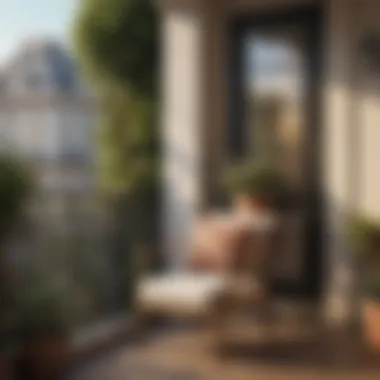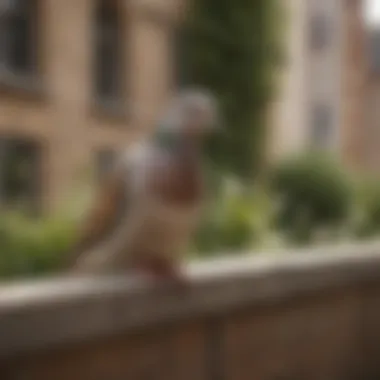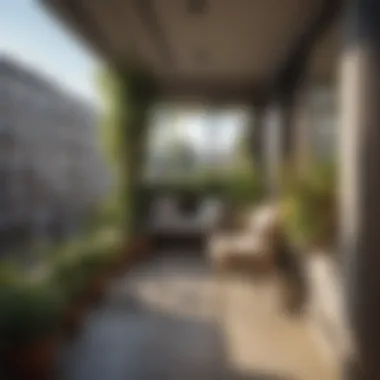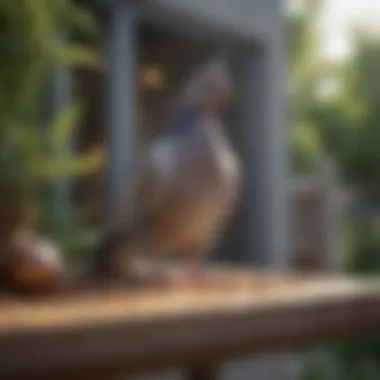Effective Strategies to Deter Doves from Your Balcony


Intro
Doves can be charming but can also become a nuisance when they take over your balcony. Their cooing, nesting behavior, and droppings may disrupt the peace of your home environment. Understanding dove behavior is crucial in developing effective strategies to discourage them. This article offers insight into practical, humane deterrent methods, ensuring your outdoor space remains pleasant.
Design Inspiration
While focusing on deterring doves, incorporating design elements that can help accomplish this is essential.
Trending Styles
A minimalist and modern style may be beneficial. Consider sleek and clean lines in your balcony furniture and decor. This less cluttered environment not only looks aesthetically pleasing but also reduces potential nesting spots for doves.
Color Palettes
Doves feel more secure in spaces with natural colors. Utilizing bold or bright colors on your balcony may deter them. Instead, muted tones such as grays, whites, and browns can create an environment that feels less welcoming to these birds.
Practical Tips
Effectively deterring doves requires a mixture of strategies. Here are some practical methods to consider.
Maintenance & Care
Regular maintenance of your balcony is key. Keep it clean and free of debris where doves might want to nest or perch. Remove any food sources that may attract them. This may include sweeping up any leftover crumbs from your outdoor dining.
Budgeting & Planning
Implementing these strategies can vary in cost. Evaluate what deterrents align with your budget and preferences. Simple options, such as reflective surfaces or decoys, can be effective without requiring a large investment. You may want to gradually incorporate changes, allowing you to see what works best in your specific environment.
"A clean and well-maintained balcony not only looks good but also dissuades unwanted birds from taking residence."
By incorporating behavior awareness with physical modifications, you will create a space that is less appealing to doves. Keeping up with consistent care will ensure your balcony remains a serene retreat, free from the disturbances caused by these birds.
Understanding Dove Behavior
Understanding dove behavior is crucial for homeowners aiming to keep their balconies free from these persistent birds. Doves, known for their gentle nature, can become frequent visitors. Their presence might initially seem harmless, but continued inhabitation can lead to several issues including mess, noise, and potential damage to property. By grasping the underlying motivations for their attraction to balconies, individuals can adopt effective strategies to deter them. Factors like food availability and safe nesting spots often drive doves to favor certain areas.
Common Reasons for Dove Presence
Doves are naturally drawn to locations that fulfill their basic needs. The common reasons for their presence include:
- Food Availability: Doves often search for seeds, fruits, and other food sources. Balconies that have accessible food or crumbs scattered can attract them.
- Safe Perching Spots: Balconies provide an elevated and relatively safe surface for doves to rest. Birds tend to favor places where they can escape predators easily.
- Nesting Opportunities: If a balcony offers suitable locations for nesting, doves may settle down. Plants, furniture, or even small ledges can serve as ideal nesting spots.
To effectively address the issue, homeowners should first assess what might be attracting these birds.
Dove Habits and Nesting Patterns
Doves exhibit specific habits that contribute to their presence on balconies. Understanding these habits is pivotal in implementing deterrent strategies. Doves are monogamous and often return to the same nesting sites year after year. They typically prefer areas that provide shelter and seclusion.
- Nesting: Doves build simple nests from twigs and other materials. They usually pick hidden spots, which may include nooks on balconies adorned with flower pots or decorative pieces.
- Feeding Behavior: Doves often feed in the early morning or late afternoon. They tend to forage for food on the ground, which means any spilled food could lure them.
- Social Structure: Doves are social birds and often travel in pairs or small groups. This social nature can increase the number of birds on a balcony if they identify it as a good location.
Recognizing these behaviors can significantly empower homeowners to create environments that discourage doves from frequenting their spaces.
It is essential to remember that while doves can seem like a nuisance, understanding their behavior and needs is the first step toward successful deterrence.
Impact of Doves on Balconies
Doves, often seen as harmless birds, can have significant effects on balconies. Understanding these impacts is essential for homeowners who wish to maintain both functionality and aesthetics of their outdoor spaces. The presence of doves can lead to a variety of issues ranging from physical damage to health concerns, both of which can considerably affect enjoyment and safety of these areas.
Physical Damage and Cleanliness Issues
One of the most immediate impacts of doves on balconies is the potential for physical damage. Doves are known to nest and perch in areas that seem attractive to them, including balconies. Their nesting activities can result in damage to outdoor furniture, railings, and other structural elements. Additionally, doves' droppings can corrode materials over time, leading to costly repairs.


Moreover, the accumulation of droppings creates cleanliness issues. This waste can be unsightly and difficult to clean once it hardens. Regular cleaning becomes necessary to maintain a hygienic space. When droppings are not managed, they attract other pests, further complicating the cleanliness of the area.
- Dove droppings can cause:
- Damage to outdoor decor and furniture
- Long-term corrosion of metal surfaces
- Unpleasant odors and visual clutter
Health Concerns Related to Bird Accumulations
Apart from the aesthetic issues, there are serious health risks associated with dove presence on balconies. Accumulations of bird droppings can harbor pathogens, increasing the risk of disease transmission. Common illnesses associated with bird droppings include histoplasmosis, cryptococcosis, and psittacosis. These diseases can affect humans directly or indirectly through exposure to contaminated surfaces.
Families with children or individuals with preexisting health conditions should be especially careful, as they may be more susceptible to these health risks. Additionally, the presence of doves could imply an increased chance of parasites, like mites, which can lead to further discomfort and health issues.
"Investing time in effective dove deterrence is critical not just for maintaining a clean space but also for safeguarding your health and peace of mind."
Natural Deterrents to Keep Doves Away
Natural deterrents play a crucial role in managing dove populations on balconies. They are environmentally friendly solutions that do not harm the birds while addressing the concerns associated with their presence. Using such methods can promote a peaceful coexistence with wildlife. Homeowners who rely on natural strategies can often find more sustainable solutions that ultimately lead to long-term success. It's important to consider various factors such as the local habitat, dove behavior, and the specific characteristics of your outdoor space when exploring these deterrents.
Using Scents to Repel Doves
One effective natural method to deter doves is through specific scents. Doves are sensitive to certain aromas. They can find strong odors unpleasant. Therefore, using scents that doves dislike helps in keeping them at bay.
Common scents you might consider include:
- Cayenne pepper: A spicy odor that doves tend to avoid.
- Vinegar: A strong smell that can deter birds.
- Essential oils: Oils like peppermint or citrus can be effective.
You can apply these scents in various ways. Spraying diluted vinegar on surfaces can prevent doves from perching. Mixing cayenne pepper with water and using it as a spray can also provide an effective repellent. Additionally, using cotton balls soaked in essential oils around your balcony can create an uninviting environment for doves without causing them harm.
Sound Devices as Deterrents
Sound devices are another innovative deterrent. Birds like doves are adept at recognizing familiar sounds, which makes the introduction of unfamiliar noises an effective strategy. These devices can create unexpected sounds that disrupt doves and discourage them from perching.
Several options to consider include:
- Ultrasonic bird repellers: They emit sounds at frequencies that are inaudible to humans but disruptive to birds.
- Recorded distress calls: Playing sounds of distressed doves can signal danger.
- Wind chimes: Natural movement and sound can create an unsteady environment for doves.
This acoustic deterrent method is not harmful and ensures your balcony maintains its outdoor charm while effectively reducing dove visits.
Visual Scares: Reflective Surfaces and Decoys
Visual deterrents can also play a significant role in discouraging doves. Birds are easily startled by unexpected movements or reflections. Using reflective surfaces or decoys can create a sense of chaos that doves prefer to avoid.
Consider implementing the following visual strategies:
- Reflective tape: Hanging strips of shiny tape can flutter in the wind, catching the light and confusing doves.
- Scare balloons: Balloons with predator designs can scare off doves from a distance.
- Plastic owls or hawks: These can simulate potential threats and keep doves from approaching.
Maintaining these visual deterrents as part of your balcony décor can provide an ongoing solution to dove problems while adding interesting visual elements to your space.
Physical Modifications for Your Balcony
Physical modifications are critical for homeowners who wish to deter doves from their balconies. These adjustments create an unwelcoming environment for the birds, significantly reducing their inclination to perch or nest in these areas. Implementing modifications not only addresses aesthetic concerns but also provides long-term protection against potential damage caused by droppings or nesting debris. In this section, we will explore two effective strategies: the installation of bird spikes and creating barriers with netting.
Installation of Bird Spikes
Bird spikes serve as a practical and humane measure to keep doves from landing on balconies. These spikes can be affixed to railing edges, ledges, and other surfaces where doves commonly rest. With a design that is uninviting yet not harmful, bird spikes prevent the birds from gaining a stable perch.
When installing bird spikes, several factors should be considered:
- Placement: Identify areas where doves tend to congregate, ensuring spikes are strategically positioned to maximize effectiveness.
- Material Quality: Opt for durable materials like stainless steel or high-quality plastic. This prevents wear from weather conditions, thus enhancing longevity.
- Aesthetic Considerations: Many bird spikes are designed to be discreet and blend with the balcony’s décor. Finding a design that fits can maintain the visual appeal of your outdoor space.
By employing bird spikes, homeowners can significantly reduce dove presence without causing them harm. The conversion of a once inviting perch into a less hospitable location fosters an environment that discourages these birds from returning.


Creating Barriers with Netting
Netting provides another effective solution for balconies with persistent dove issues. Installing netting creates a physical barrier that prevents doves from accessing certain areas, particularly those used for nesting. This method is beneficial for protecting planters or open areas that may attract the birds.
Consider these key elements when utilizing netting:
- Type of Netting: Choosing the right type is essential. Look for bird netting made from UV-resistant material that can withstand outdoor exposure.
- Installation Technique: Ensure netting is secured properly. This may require anchoring points or frames to keep it taut and effective.
- Height and Coverage: Coverage should extend to all vulnerable areas, but remain unobtrusive so that it does not detract from the overall appearance of the balcony.
Utilizing netting represents a proactive approach to managing dove populations. The creation of barriers not only prevents nesting but can also discourage doves from returning, ensuring a more comfortable space for homeowners.
By implementing these physical modifications, homeowners can create a less attractive environment for doves, significantly decreasing their chances of enduring presence on balconies.
Environmental Changes to Discourage Doves
In the ongoing battle against doves invading your space, modifying the environment around your balcony plays a crucial role. Understanding that doves are attracted to certain elements in their surroundings can help homeowners create deterrent conditions. By focusing on two primary factors—food and water sources—balcony owners can reduce the allure for doves, ultimately leading to a more peaceful outdoor area.
Altering the environment is not only an effective strategy but also promotes proactive maintenance of your living space. By changing the conditions that support dove attraction, you minimize the potential for nests or unwanted gatherings. These adjustments require some effort but yield significant benefits for long-term peace of mind.
Minimizing Food Sources
Doves, like many birds, depend on food for survival, especially in urban settings. Your balcony may unintentionally provide excellent dining opportunities. To minimize food sources for doves, consider the following:
- Avoid Feeding Birds: Refrain from leaving bird feeders or bait that might attract doves. Birdseed can often serve as a magnet for these birds.
- Clean Up Crumbs: Regularly sweep or clean your balcony to ensure no food scraps are available. Even small amounts can draw doves in.
- Secure Trash Bins: Ensure that trash receptacles are tightly sealed and use containers that doves cannot access. Unsecured trash can easily lure them closer.
Ultimately, creating an uninviting dining environment is essential. The fewer food sources available, the less likely doves will consider your balcony a feeding ground.
Altering Water Sources in Proximity
Water sources can similarly attract doves, who need water for drinking and bathing. It’s essential to take measures that reduce their access to water nearby:
- Remove Standing Water: Doves are drawn to standing water, which can be present in plant trays, pools, or puddles. Regularly check for and eliminate these spots.
- Check Outdoor Faucets: Ensure that outdoor faucets are not dripping or pooling water. Fix leaks to prevent doves from grabbing a drink.
- Redirect Water Flow: If possible, redirect any water runoff away from your balcony. Landscaping changes or drainage methods can help disrupt easy access.
By managing water accessibility, you can further discourage doves from lingering in your vicinity. Less water means less attraction.
By implementing these environmental changes, you can create a less hospitable atmosphere for doves, steering them away from your balcony and promoting a more peaceful outdoor space.
Technical Solutions for Dove Deterrence
The use of technical solutions for deterring doves offers innovative ways to address the ongoing challenge of keeping these birds away from balconies. Traditional methods, while sometimes effective, may require constant supervision and manual intervention. In contrast, technical solutions provide a more automated and long-lasting approach. Not only can these solutions save time, but they can also enhance the effectiveness of deterrents against dove presence.
Integrating technology into dove deterrence strategies allows homeowners to reduce their own effort while ensuring their environment remains pleasant and clean. These methods tend to focus on creating disruptions in the doves' routines, making the area less appealing to them. In this section, we will look into various technical solutions, emphasizing their benefits and addressing practical considerations for implementation.
Utilizing Motion-Activated Devices
Motion-activated devices have gained popularity due to their effectiveness in repelling birds like doves. When these devices detect movement, they activate certain measures designed to frighten the birds away. Common forms of motion-activated equipment include:
- Sprinklers: These devices spray water when they sense movement, startling the doves and encouraging them to leave.
- Noisemakers: Devices that emit loud sounds when triggered can also effectively keep doves at bay. Sudden noise can disrupt their behavior and deter them from settling.
The important aspect of motion-activated devices is that they require minimal maintenance once set up. They effectively use the element of surprise to startle the birds. However, there are some considerations to keep in mind:
- Placement: Proper positioning can increase the effectiveness. Mounting devices where doves frequently perch can yield the best results.
- Sensitivity Settings: Devices should be tailored to avoid continuous activation from passing pets, so sensitivity settings may need adjustment.
Advanced Sound Deterrent Systems
Advanced sound deterrent systems offer a sophisticated alternative for repelling doves. These systems utilize recorded sounds or frequencies that are unpleasant to doves. Certain sounds, such as the calls of predatory birds or specific loud noises, can create an environment that feels unsafe for these birds.
Key features of these systems may include:
- Programmable Sounds: Users can plan the timing and variety of sounds that are played throughout the day.
- Range: Some systems can project sound over large distances, making them suitable for extensive outdoor areas.
While these systems can be effective, they may present some challenges:


- Volume Control: Continuous loud noise could potentially disturb neighbors, so finding a balance in volume is essential.
- Legality and Ethics: Check local regulations to ensure that sound deterrent systems comply with noise ordinances and humane treatment laws.
In summary, both motion-activated devices and advanced sound deterrent systems are key technical solutions for keeping doves away from balconies. They allow for a seamless approach to maintaining a peaceful outdoor space without needing constant human intervention. Careful consideration of device placement and adherence to local regulations will ensure the successful application of these methods.
Legal and Ethical Considerations
Understanding the legal and ethical dimensions surrounding dove deterrence is crucial for homeowners who wish to maintain their balconies in a humane manner. While it is often necessary to take steps to prevent doves from nesting or roosting, it is equally important to comply with wildlife protection laws. These laws are established to protect various bird species, including doves, from mistreatment and harm.
Understanding Wildlife Protection Laws
Wildlife protection laws vary by country and region, but many areas have specific regulations that protect migratory birds. For instance, the Migratory Bird Treaty Act in the United States is a key piece of legislation. This act prohibits the killing, capturing, or selling of migratory birds, including doves, without proper permits. Homeowners need to be aware of these regulations. Ignoring them could lead to legal consequences and fines.
To ensure compliance, it can be beneficial to research local regulations regarding bird control. You might find resources from organizations like the U.S. Fish and Wildlife Service or your local wildlife management authority. Some states may have specific guidelines on how to humanely deter birds while ensuring their protection.
Promoting Humane Treatment of Birds
In pursuing dove deterrence, promoting humane treatment of birds should always be a priority. This approach aligns with both ethical considerations and legal requirements. Homeowners can adopt non-lethal methods for deterring doves, which contribute to a balanced ecosystem without causing harm.
To promote humane treatment, consider the following strategies:
- Educate Yourself and Others: Share knowledge about doves' behaviors and how to coexist without harming them. Understanding their nesting habits and dietary needs can provide insight into effective and ethical deterrent methods.
- Choose Non-Lethal Deterrents: Focus on strategies like visual scares, sound devices, and environmental modifications to discourage dove presence without harming them. This not only aligns with ethical standards but also often proves to be effective.
- Engage with Local Conservation Groups: Collaborate with organizations dedicated to bird conservation. They often provide resources, workshops, or expert advice on humane bird control methods.
Promoting humane treatment maintains the ecological balance and illustrates a commitment to responsible home ownership. By following the legal guidelines and prioritizing animal welfare, homeowners can effectively manage dove issues while respecting the rights and roles of wildlife in their environment.
"Legal compliance coupled with humane treatment reflects a responsible approach not just to doves, but to our shared environment."
Long-Term Maintenance Strategies
Long-term maintenance strategies are vital for ensuring that your balcony remains free from doves. This approach offers a proactive method for managing the presence of these birds, rather than reactive measures that may prove less effective over time. By focusing on consistent efforts, homeowners can safeguard their outdoor spaces from potential damage and ensure cleanliness.
Factors to consider in long-term maintenance include regular assessments of the balcony environment, systematic removal of attractants, and the implementation of barriers. These practices help to identify any new nesting opportunities and act swiftly against them.
Regular Inspections and Remediation
Regular inspections are an essential step in maintaining a dove-free balcony. These checks should occur at least once a month to look for signs of dove activity, such as feathers or droppings. Look for any potential nesting sites, like sheltered areas or nooks where doves might seek refuge.
When evidence of doves is found, immediate remediation is necessary. This may involve physically removing any nests or blocking access to potential nesting areas by using bird spikes or netting. Additionally, cleaning up any debris and droppings not only helps with cleanliness but also deters doves from returning.
"Prevention is far more effective than dealing with a persistent problem later."
Seasonal Strategies for Dove Prevention
Seasonal changes can significantly affect dove behavior, making it crucial to adapt your prevention techniques accordingly. During spring and summer, doves are more active and may seek out nesting areas, making inspections even more critical during this time.
In the fall and winter, you might focus on cleaning and securing food sources. Ensure that no remnants of bird feed or pet food are left out, as these can attract doves.
Some strategies also involve adjusting visual deterrents and maintaining barriers. For instance, check your reflective surfaces to ensure they are properly positioned to frighten doves away. Regular maintenance of these deterrents helps keep your balcony looking appealing while also making it less inviting for doves.
Implementing a combination of these seasonal observations and inspections will yield lasting results. Conducting these strategies year-round can greatly diminish the chances of doves choosing your balcony as their home.
End
Detering doves from balconies requires a blend of understanding, strategy, and consistency. It is essential to remember that these birds often seek safe spaces, and our balconies can become attractive sites for nesting and resting. Thus, implementing effective and humane techniques can greatly enhance the enjoyment of these outdoor areas.
Summary of Effective Techniques
Utilizing various strategies is key in keeping doves at bay. Here are the most effective methods:
- Utilize scents: Strong odors, such as vinegar or citrus, can repel doves. Spraying these around the balcony might deter them.
- Sound devices: Employing noise makers or wind chimes can disrupt the atmosphere that doves find welcoming.
- Visual deterrents: Consider reflective surfaces or decoys to mimic predators, discouraging doves from settling.
- Physical barriers: Installing bird spikes or netting can significantly reduce perching and nesting opportunities.
- Regular cleaning: Keeping the balcony free of debris will minimize food sources.
- Seasonal strategies: Different seasons may require adapted strategies to address changes in dove behavior and nesting patterns.
Each of these strategies is notable due to their effectiveness and humane nature, emphasizing respect for wildlife. By implementing combinations of these methods, one can establish a safer and more peaceful outdoor environment.
Encouraging a Peaceful Outdoor Space
Encouraging a tranquil balcony environment goes beyond just removing doves. It is about creating a space that is both inviting for humans and not conducive for birds.
- Cleanliness: Regularly removing food and waste can make the area less attractive to doves.
- Appropriate planting: Incorporating plants that do not attract doves can assist in maintaining balance in the ecosystem of the property.
- Mindful seating arrangement: Positioning furniture away from edges and using covers can discourage doves from feeling secure in that area.
In summary, fostering a serene space requires careful planning and execution. If homeowners thoughtfully consider their environment and apply effective techniques, they can enjoy their balconies without unwanted visitors.















